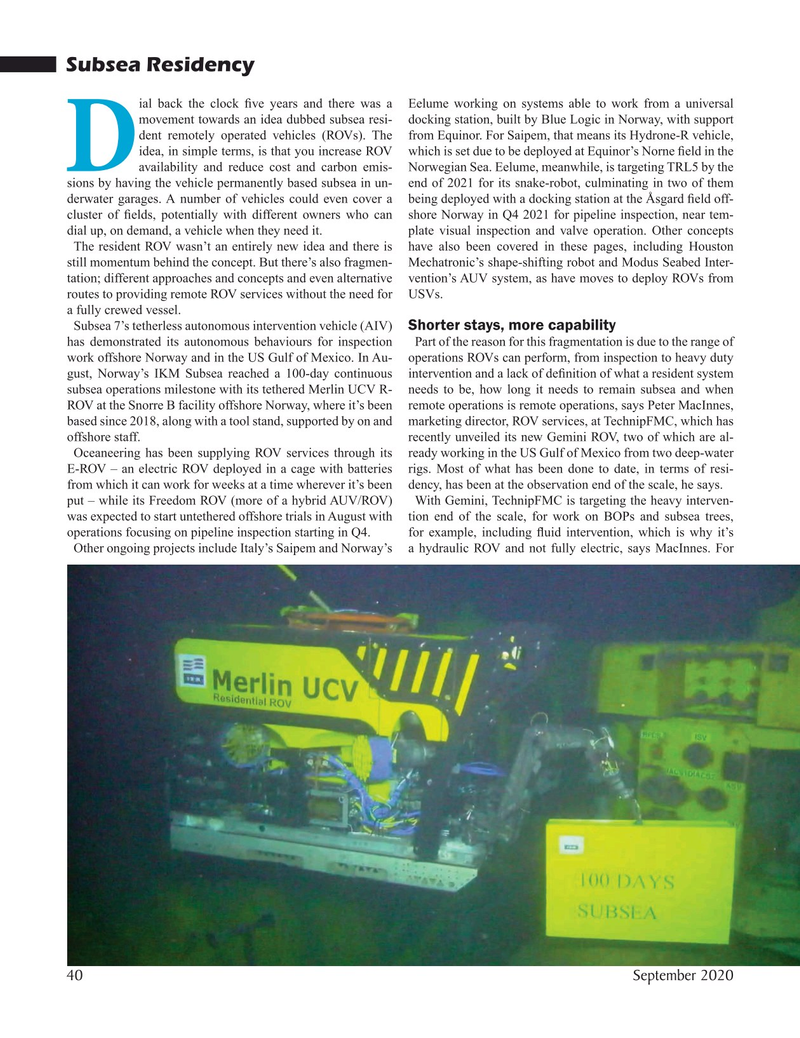
Page 40: of Marine Technology Magazine (September 2020)
Read this page in Pdf, Flash or Html5 edition of September 2020 Marine Technology Magazine
Subsea Residency ial back the clock ? ve years and there was a Eelume working on systems able to work from a universal movement towards an idea dubbed subsea resi- docking station, built by Blue Logic in Norway, with support dent remotely operated vehicles (ROVs). The from Equinor. For Saipem, that means its Hydrone-R vehicle, idea, in simple terms, is that you increase ROV which is set due to be deployed at Equinor’s Norne ? eld in the
Davailability and reduce cost and carbon emis- Norwegian Sea. Eelume, meanwhile, is targeting TRL5 by the sions by having the vehicle permanently based subsea in un- end of 2021 for its snake-robot, culminating in two of them derwater garages. A number of vehicles could even cover a being deployed with a docking station at the Åsgard ? eld off- cluster of ? elds, potentially with different owners who can shore Norway in Q4 2021 for pipeline inspection, near tem- dial up, on demand, a vehicle when they need it. plate visual inspection and valve operation. Other concepts
The resident ROV wasn’t an entirely new idea and there is have also been covered in these pages, including Houston still momentum behind the concept. But there’s also fragmen- Mechatronic’s shape-shifting robot and Modus Seabed Inter- tation; different approaches and concepts and even alternative vention’s AUV system, as have moves to deploy ROVs from routes to providing remote ROV services without the need for USVs. a fully crewed vessel.
Subsea 7’s tetherless autonomous intervention vehicle (AIV) Shorter stays, more capability has demonstrated its autonomous behaviours for inspection Part of the reason for this fragmentation is due to the range of work offshore Norway and in the US Gulf of Mexico. In Au- operations ROVs can perform, from inspection to heavy duty gust, Norway’s IKM Subsea reached a 100-day continuous intervention and a lack of de? nition of what a resident system subsea operations milestone with its tethered Merlin UCV R- needs to be, how long it needs to remain subsea and when
ROV at the Snorre B facility offshore Norway, where it’s been remote operations is remote operations, says Peter MacInnes, based since 2018, along with a tool stand, supported by on and marketing director, ROV services, at TechnipFMC, which has offshore staff. recently unveiled its new Gemini ROV, two of which are al-
Oceaneering has been supplying ROV services through its ready working in the US Gulf of Mexico from two deep-water
E-ROV – an electric ROV deployed in a cage with batteries rigs. Most of what has been done to date, in terms of resi- from which it can work for weeks at a time wherever it’s been dency, has been at the observation end of the scale, he says. put – while its Freedom ROV (more of a hybrid AUV/ROV) With Gemini, TechnipFMC is targeting the heavy interven- was expected to start untethered offshore trials in August with tion end of the scale, for work on BOPs and subsea trees, operations focusing on pipeline inspection starting in Q4. for example, including ? uid intervention, which is why it’s
Other ongoing projects include Italy’s Saipem and Norway’s a hydraulic ROV and not fully electric, says MacInnes. For 40 September 2020
MTR #7 (34-49).indd 40 9/11/2020 9:38:45 AM

 39
39

 41
41
